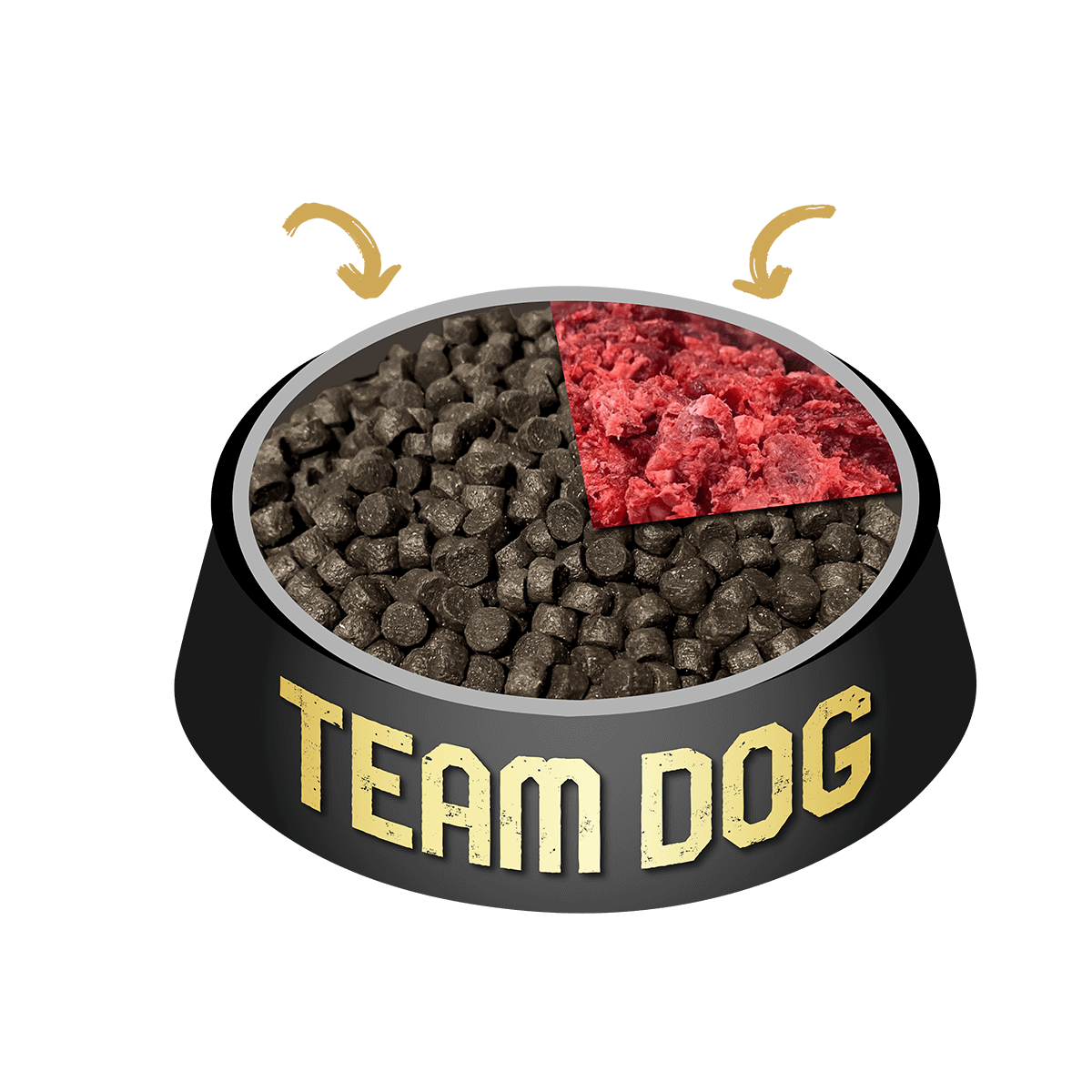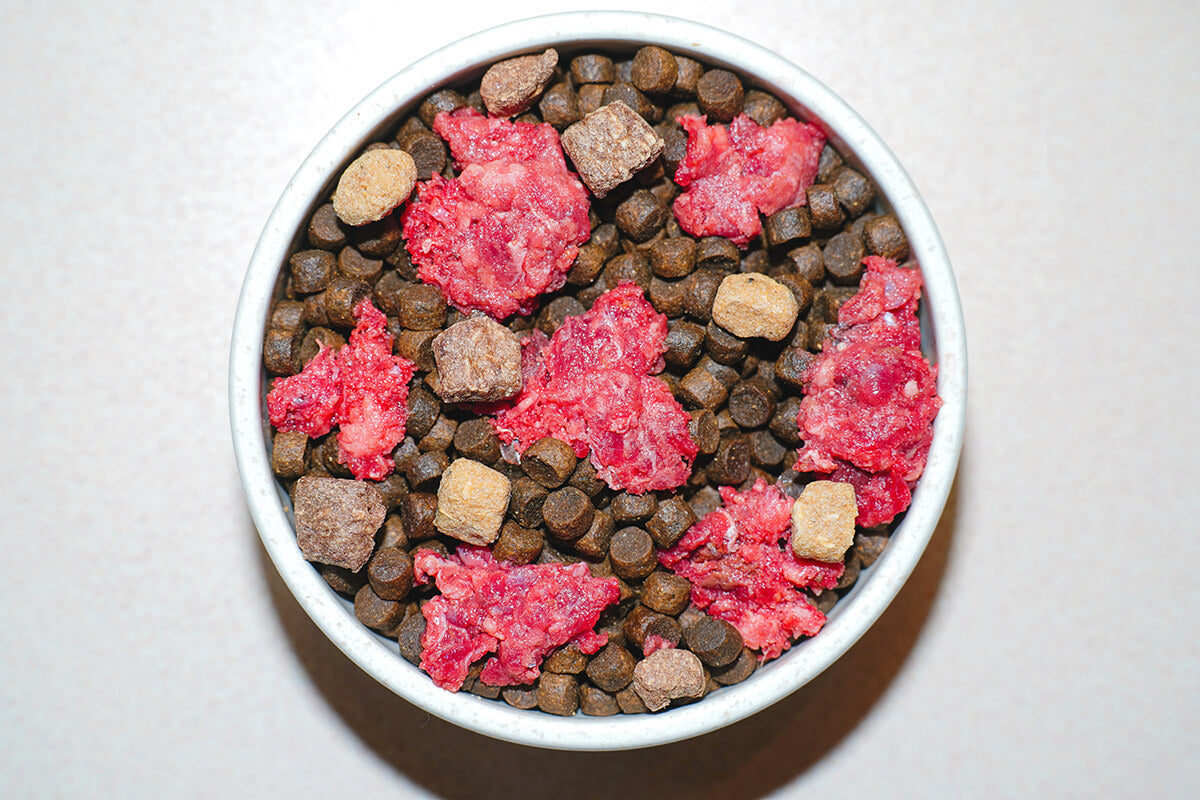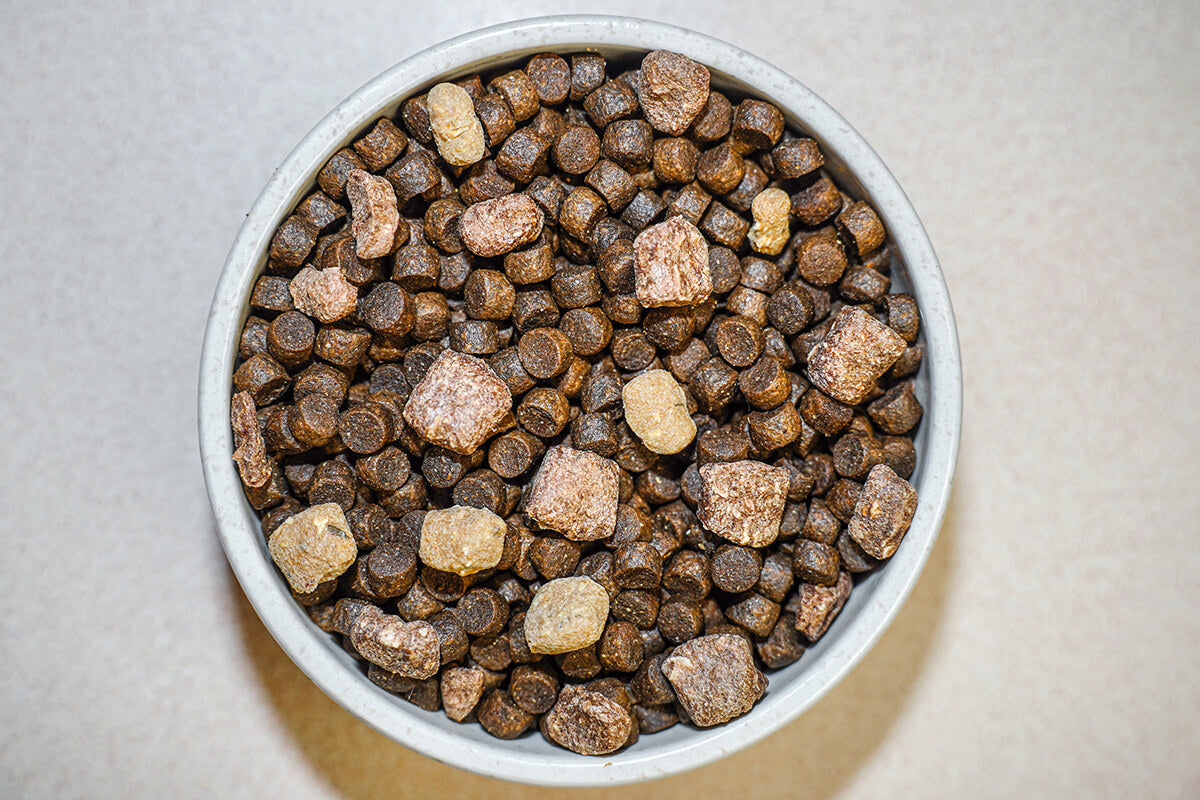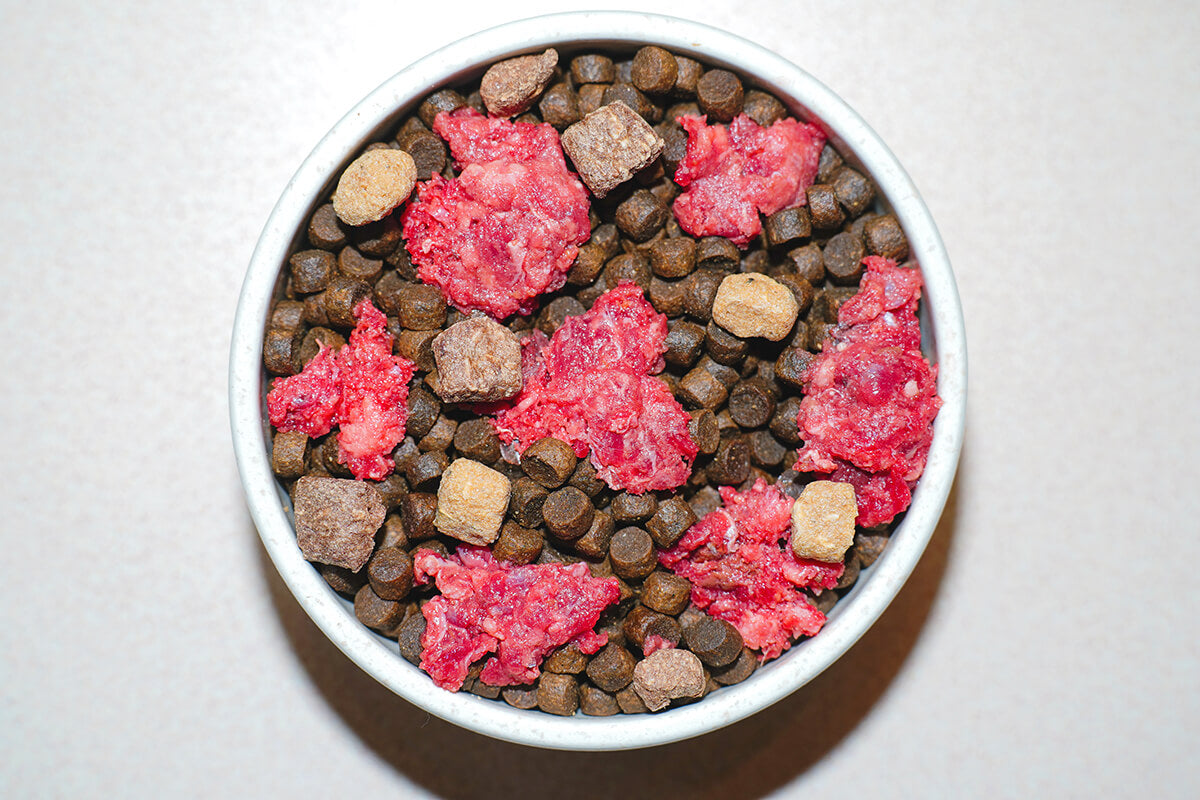Team Dog promotes a 75/25 approach to raw feeding
If you have been been feeding your dog Team Dog Essential or Elite, you can immediately begin feeding 75% dry food and 25% Team Dog Primal raw food for maximum benefits. Team Dog Primal is suitable for dogs over 1 year old.
Switching to this method may result in stool changes that are common and harmless.

Feeding Raw the Team Dog Way
Supplement with Team Dog Primal
Dry
Dry + Raw


The gastrointestinal tract (GI) of dogs can tolerate low levels of pathogens better than humans since their stomachs and GI tracts are more acidic and their GI tracts are shorter than humans. 3
- However, raw food is not recommended for dogs with suppressed immune systems (from significant illness or immunosuppressant medications). Moreover, dogs with severe chronic conditions such as moderately advanced heart, kidney, or liver disfunction or cancer should not be fed raw food since the food may contain pathogens.
- Additionally, since there is a risk of contamination when handling raw food, it’s important to practice safe food handling and sanitary hygiene habits such as frequent handwashing when preparing raw dog food.
Handling raw pet food can increase the risk of exposing the pet parent, pet, and family to harmful bacteria. Further, this content should not be considered or used as a substitute for veterinary medical advice.
Blood testing results from raw fed dogs usually differ from kibble fed dogs. Below are four common blood test markers and what they measure as well as a summary table of these markers in raw and kibble fed dogs. Data from this table were taken from two studies of over 230 dogs of various breeds fed a raw diet for 4.5-9 months compared to dogs fed dry kibble. 1, 2
- Alanine aminotransferase (ALT) is a marker of liver damage.
- Decreased ALT levels are rarely clinically significant but may indicate malnutrition or starvation.
- Increased ALT is mainly driven by toxin ingestion or chronic inflammation of the liver due to an infection or genetic disorder. Higher ALT levels can also be caused by heart failure and intestinal inflammation. - Blood urea nitrogen (BUN) assess protein breakdown and usually reflects kidney function.
- Reduced levels of BUN are generally due to liver damage, inadequate protein intake, or protein malabsorption.
- Elevated BUN levels can be caused by kidney damage, intestinal bleeding, or heart failure as well as low fluid intake, exercise, or decreased digestive enzyme production in the pancreas. Certain drugs can also increase BUN levels. It’s also important to note that raw fed dogs usually have elevated BUN levels since they consume more protein. - Creatinine measures protein breakdown.
- Lower levels of creatinine are commonly reflective of inadequate protein intake, kidney damage, liver disease, or pregnancy.
- Higher levels of creatinine are typically indicative of kidney damage and need to monitored regularly. - Hematocrit levels assess the percentage of red blood cells in whole blood.
- Decreased hematocrit is typically characterized as anemia and can be caused by a variety of factors including infection, chronic diseases, and poor nutrition.
- Increased hematocrit indicates loss of water from the plasma, usually tied to severe dehydration or from splenic contraction. This is more of a concern in dogs fed with dry kibble since raw feeding provides more moisture to the diets.
- Copper is an essential trace mineral involved in many key enzymatic and metabolic pathways. It also helps make red blood cells and absorb iron. Copper is also involved in supporting healthy skin, connective tissue, and coats.
- High copper levels in dog food can cause serious and potential lethal illness called dietary-induced copper-associated hepatopathy (CAH).
- The minimum copper levels recommended by AAFCO are 7.3 mg/kg (total diet) for adult dogs at maintenance and 12.4 mg/kg (total diet) for growth and reproduction periods or for all life stages (Dry Matter). Additionally, in 2007, AAFCO removed its recommended safe upper limit for copper which was 250 mg/kg (Dry Matter).
- Team Dog’s dry food contain 24- 50 mg/kg of copper, depending on the specific blend (Dry Matter).
- While Team Dog’s copper content may be on par with other commercial brands with elevated copper levels, the risk for developing CAH from Team Dog’s food blends is extremely low since Team Dog’s feeding guidelines (max 4 cups/day) are significantly lower than commercial blends (most recommend 5 cups with ½ cup additions for every 10 pounds for dogs over 100 pounds).
- All of Team Dog’s offerings have been developed and reviewed by independent veterinarians, animal nutritionists and PhDs specializing in nutrition to be nutritionally complete and balanced.
A recent 2017 study showed that feeding a mixed diet that includes raw food promoted a more balanced microbiome and resulted in positive shifts in markers of a healthy gut. 4
- Dr. Jean Dodds’ Pet Health Resource Blog | Raw Diets and Bloodwork Results: Should you be... Accessed April 1, 2024. https://drjeandoddspethealthresource.tumblr.com/post/134679160366/raw-diet-bloodwork-dog
- Anturaniemi J, Zaldívar-López S, Moore R, et al. The effect of a raw vs dry diet on serum biochemical, hematologic, blood iron, B12, and folate levels in Staffordshire Bull Terriers. Vet Clin Pathol. 2020;49(2):258-269. doi:10.1111/VCP.12852
- Dressman JB. Comparison of canine and human gastrointestinal physiology. Pharm Res. 1986;3(3):123-131. doi:10.1023/A:1016353705970.
- Sandri M, Dal Monego S, Conte G, Sgorlon S, Stefanon B. Raw meat based diet influences faecal microbiome and end products of fermentation in healthy dogs. BMC Vet Res. 2017;13(1):1-11. doi:10.1186/S12917-017-0981-Z/TABLES/5
- Bermingham EN, Maclean P, Thomas DG, Cave NJ, Young W. Key bacterial families (Clostridiaceae, Erysipelotrichaceae and Bacteroidaceae) are related to the digestion of protein and energy in dogs. PeerJ. 2017;5(3). doi:10.7717/PEERJ.3019
- Geary EL, Parsons CM, Utterback PL, Templeman JR, Swanson KS. Standardized amino acid digestibility and nitrogen-corrected true metabolizable energy of frozen raw, freeze-dried raw, fresh, and extruded dog foods using precision-fed cecectomized and conventional rooster assays. J Anim Sci. 2023;101. doi:10.1093/JAS/SKAD377
- Stogdale L. One veterinarian’s experience with owners who are feeding raw meat to their pets. The Canadian Veterinary Journal. 2019;60(6):655. Accessed April 2, 2024. /pmc/articles/PMC6515799/
- Kulczyński B, Sidor A, Gramza-Michałowska A. Characteristics of Selected Antioxidative and Bioactive Compounds in Meat and Animal Origin Products. Antioxidants. 2019;8(9). doi:10.3390/ANTIOX8090335
- Schmidt M, Unterer S, Suchodolski JS, et al. The fecal microbiome and metabolome differs between dogs fed Bones and Raw Food (BARF) diets and dogs fed commercial diets. PLoS One. 2018;13(8):e0201279. doi:10.1371/JOURNAL.PONE.0201279
- Algya KM, Cross TWL, Leuck KN, et al. Apparent total-tract macronutrient digestibility, serum chemistry, urinalysis, and fecal characteristics, metabolites and microbiota of adult dogs fed extruded, mildly cooked, and raw diets1. J Anim Sci. 2018;96(9):3670 -3683. doi:10.1093/JAS/SKY235
- Kim J, An JU, Kim W, Lee S, Cho S. Differences in the gut microbiota of dogs (Canis lupus familiaris) fed a natural diet or a commercial feed revealed by the Illumina MiSeq platform. Gut Pathog. 2017;9(1):1-11. doi:10.1186/S13099-017-0218-5/FIGURES/4
- Anderson RC, Armstrong KM, Young W, Maclean P, Thomas DG, Bermingham EN. Effect of kibble and raw meat diets on peripheral blood mononuclear cell gene expression profile in dogs. The Veterinary Journal. 2018;234:7-10.doi:10.1016/J.TVJL.2018.01.005
- Hemida MBM, Salin S, Vuori KA, et al. Puppyhood diet as a factor in the development of owner‐reported allergy/atopy skin signs in adult dogs in Finland. J Vet Intern Med. 2021;35(5):2374. doi:10.1111/JVIM.16211
- Hemida MBM, Vuori KA, Moore R, et al. Response to letter regarding “Puppyhood diet as a factor in the development of owner‐reported allergy/atopy skin signs in adult dogs in Finland.” J Vet Intern Med. 2022;36(5):1564. doi:10.1111/JVIM.16489
- Morelli G, Bastianello S, Catellani P, Ricci R. Raw meat-based diets for dogs: Survey of owners’ motivations, attitudes and practices. BMC Vet Res. 2019;15(1):1-10. doi:10.1186/S12917-019-1824-X/FIGURES/4












